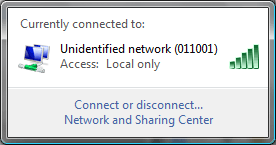[section_title title=Details]
2011-03-14 – Update: Please make sure to first try the automated fix provided by Microsoft in the knowledge base article (look for the “Fix it” icon).
Recently I had issues with Windows Vista where it would get on a network, but would only have local access (i.e. “Access: Local only” in the Network and Sharing Center). After spending about an hour and a half I finally stumbled across the solution. Once again, the solution was hidden in a forum, and the Microsoft knowledge base article was fairly hard to follow. So, here are the steps summarized for quickly fixing this1.
- First we have to find the name of network adapter that you are using to connect, you can skip this if you know the name of your network adapter.
- Open Network and Sharing Center (Start > Control Panel > Network and Sharing Center)
- Click on “Manage network connections” under “Tasks” on the left side.
- Note the name of the device in “Device Name” column for the connection that you are using (e.g. Intel® PRO/Wireless 3945ABG Network Connection)
- Now we have to find the GUID of this adapter.
- Open the registry editor: Start > type in ‘regedit’
- Navigate to HKEY_LOCAL_MACHINE\SOFTWARE\Microsoft\Windows NT\CurrentVersion\NetworkCards\
- Look through the numbered sub-keys and jot down the “ServiceName” for the one that has the name of your network card in the “Description.”
- Keep the registry editor open because we will be changing another key in the next step.
- Once you have the GUID of the network then we have to toggle the broadcast flags.
- Navigate to HKEY_LOCAL_MACHINE\SYSTEM\CurrentControlSet\Services\Tcpip\Parameters\Interfaces
- Now follow the resolution in the Microsoft knowledge base article
- Make sure to set the DhcpConnForceBroadcastFlag as described in the “More Information” section of the knowledge base article.
- Finally, restart the computer.
Hopefully, after restarting the computer you will be able to access the internet.
1Disclaimer, before playing around with the registry make sure to back it up first.
A Few Other Things to Try
Here are a few other things to try in case the above doesn’t work. These are based on the comments that people have left below.
- Try uninstalling the wireless card drivers, restarting the computer and then reinstalling the wireless card drivers (see your manufacturer’s website). This seems to have fixed the issue for a few folks.
- Try resetting your router.
- Try the automated “Fix it” in the Microsoft Knowledge base article.
- Try a different channel.
- Try changing the IP address range (generally 192.168.0.xxx, change to something like 192.168.9.xxx).
- Try a different security method (WEP vs. WPA). Please understand the this change because it might leave your wireless network vulnerable.
- Try the same security method with access control list (example) on the router disabled.

